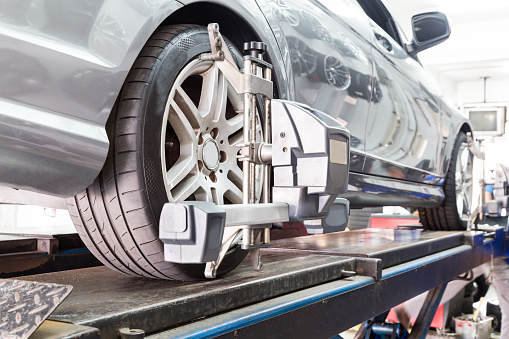February 27, 2025
DOES YOUR VEHICLE NEED WHEEL ALIGNMENT?
As an AI language model, I don’t have access to information about your specific vehicle, so I cannot determine whether or not it needs a wheel alignment. However, here are some common signs that your vehicle may need a wheel alignment:
- Your vehicle pulls to one side: If you notice that your vehicle tends to pull to one side or the other while driving straight, it could be a sign that your wheels are misaligned.
- Uneven tire wear: If your tires show uneven wear patterns, such as wear on the inside or outside edges of the tire or feathered edges, it could be a sign of misalignment.
- Steering wheel vibration: If you feel a vibration or shaking sensation in the steering wheel while driving, it could be due to misaligned wheels.
- Crooked steering wheel: If your steering wheel is not centered while driving straight, it could be a sign of misalignment.
- Squealing tires: If you hear your tires squealing while turning, it could be a sign that your wheels are misaligned.
If you notice any of these signs, it’s a good idea to take your vehicle to a professional mechanic for a wheel alignment to ensure your vehicle is safe to drive and to prevent further damage to your tires and suspension system.
The Benefits Of Having A Wheel Alignment
There are several benefits to having a wheel alignment performed on your vehicle:
- Increased safety: A properly aligned vehicle is safer to drive because it provides better handling and control. Proper alignment reduces the risk of accidents caused by poor handling or loss of control.
- Improved tire life: Misaligned wheels can cause uneven tire wear, which shortens the life of your tires. A wheel alignment can help ensure that your tires wear evenly, which can help extend their lifespan.
- Better fuel efficiency: Misaligned wheels can cause your vehicle to work harder to maintain speed, which can result in decreased fuel efficiency. Properly aligned wheels reduce resistance, which can help improve gas mileage.
- Improved handling and performance: When your wheels are properly aligned, your vehicle will handle better, which can improve its overall performance.
- Reduced maintenance costs: Misaligned wheels can cause additional wear and tear on your vehicle’s suspension system, which can lead to costly repairs. A wheel alignment can help prevent this additional wear and tear, which can save you money on maintenance costs in the long run.
Overall, having a wheel alignment performed on your vehicle can help improve safety, extend the life of your tires, improve fuel efficiency, enhance performance, and reduce maintenance costs.
When Should A Wheel Alignment Be Performed?
It is recommended to have a wheel alignment performed on your vehicle every 10,000 miles or once a year, whichever comes first. However, there are also some specific situations where you may need to have a wheel alignment sooner:
- After purchasing new tires: When you have new tires installed, it’s a good idea to have a wheel alignment performed to ensure they wear evenly and last as long as possible.
- After hitting a curb or pothole: If you hit a curb or pothole, your wheel alignment can be thrown off, and you may need to have it checked and adjusted.
- After replacing suspension components: If you’ve had any suspension components replaced, such as struts or shocks, it’s a good idea to have a wheel alignment performed to ensure everything is properly aligned.
- If you notice any of the signs of misalignment: If you notice any of the signs of misalignment, such as uneven tire wear or steering wheel vibration, you should have your vehicle inspected and aligned as soon as possible.
Overall, it’s important to have your vehicle’s wheel alignment checked regularly and after any incidents that could affect alignment. This can help ensure your vehicle is safe to drive and that your tires and suspension system last as long as possible.
How do you know if your car needs wheel balancing?
There are a few signs that can indicate your car might need wheel balancing:
-
Vibration in the Steering Wheel or Seat: If you feel vibrations in the steering wheel, especially at higher speeds, it could be a sign that your wheels are out of balance.
-
Uneven Tire Wear: If you notice uneven wear patterns on your tires, it might mean that they are not balanced properly. This can cause one part of the tire to wear down faster than others.
-
Poor Handling: If your car feels off or pulls to one side when driving, it could be due to an imbalance in the wheels.
-
Noise: Unusual or excessive noise coming from the tires, especially at higher speeds, might also be an indication that your wheels are out of balance.
-
Tire Pressure Monitoring System (TPMS) Warning: Sometimes, wheel imbalance can trigger the TPMS warning light, though this can also indicate other issues with your tires.
If you’re experiencing any of these symptoms, it’s a good idea to have your wheels balanced by a professional.

